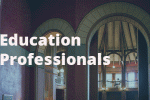VSAC transferred the servicing of your Federal Student loans to American Education Services and the guarantee of all VSAC Federal Student loans to the Trellis Company, an approved Federal Guaranty Agency, over the weekend of March 16th. CLICK HERE for more information.
Hold the Line on Debt, but Don’t Give Up the Schooling
By Don Vickers
A month ago, I joined other Vermonters in calling for more reasonable interest rates on federal education loans so that we don’t price students and their families out of higher education.
Today, I issue a word of caution — namely, that we not allow our very legitimate concerns about student and parent debt loads to cloud our judgment about the very real value of higher education.
In all the talk about student borrowing, college costs, and graduates’ job prospects, we run the risk of dissuading students — particularly the least advantaged — from getting the education or training that can change their lives.
Low-income students, and those whose families have little or no college experience, tend to have fewer college aspirations. If they do think about college, they are likely to underestimate their eligibility for financial aid and to overestimate their out-of-pocket costs.
If we want to reduce poverty, and ensure educational opportunity for all, we need to tread carefully in framing the choices facing today’s students.
Why is higher education still important?
Recent pieces in the Atlantic and The New York Times acknowledge that many college graduates are indeed struggling, but these articles also note that the situation facing high school graduates is often worse.
It’s still true that, over time, a person with a postsecondary credential will earn more than someone without it. People who continue their education also tend to have fewer periods of unemployment, better health outcomes, and increased civic engagement. They are less likely to be incarcerated or require public assistance.
This is not to say that every student needs a four-year degree, a point that VSAC has consistently emphasized when working with Vermonters. But every student does need the opportunity to acquire the skills essential for today’s job market.
But what about student debt?
College Board analysts Sandy Baum and Michael McPherson, writing in The Chronicle of Higher Education, note that the nationwide increase in student loan debt is partly due to higher individual borrowing, but is also the result of more students pursuing education beyond high school.
They found wide swings in student borrowing, depending on the institution and program attended. In general, students enrolled in for-profit colleges tended to borrow the most, while many who attended community colleges were able to graduate debt-free.
When VSAC examines its own loan portfolio, we see patterns as well. A significant number of our high-balance borrowers have pursued graduate and professional degrees — which don’t guarantee, but can often lead to, higher earnings.
Unfortunately, other borrowers have accumulated high debt because they attended expensive institutions without having enough non-loan aid or family resources; struggled at several institutions, changing majors and degrees while losing credits through transfer; or were unable to complete their degrees on time.
So how can we help students make informed decisions about education?
First, we must engage more students in career exploration — work that VSAC is committed to through our Start Where You Are and other programs. Of course, job preparation shouldn’t be the only goal of education or training. But wise career decisions can make the difference in attaining a decent standard of living while avoiding unmanageable debt.
Second, it’s clear that our society must do a better job of helping families identify programs that meet the student’s education needs without straining the household budget. Part of that process is being able to access financial aid, compare colleges’ aid offers, decide how much debt is reasonable, and have a realistic plan for repaying loans.
Finally, when it comes to college or program selection, we must continue to emphasize that “one size doesn’t fit all.” There are many types of programs, ranging from one-year training courses to professional degrees, to suit the interests and aptitudes of different kinds of students. And there are many sectors — the trades, technology, and healthcare, among them — that need skilled workers.
The bottom line is that there are a variety of avenues to a degree or certificate, and we need to encourage students to take them.
This entry was posted on Monday, July 2nd, 2012 at 1:03 pm and is filed under News & Views, VSAC News Releases. Both comments and pings are currently closed.

